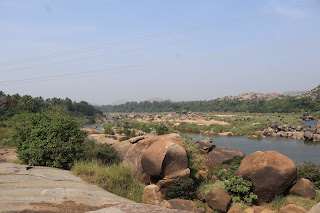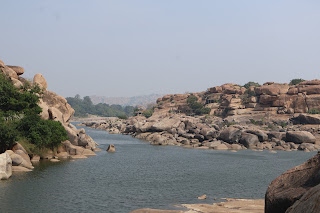The trek rout is approximately 2 km (1.2 mi) from the Hampi Bazaar, India.
It’s more of a walk along a rocky, boulder-strewn terrain than any big trekking sort of thing that involves climbing.
On an average you can walk this trail in about 45 minutes (with no major side trips). The beauty of this trek is that you can do a number of feasible side trips in this tour.
|
Entrance to the pathway |
|
Panorama of Tungabhadra river |
|
Kampabhupa Pathway «In Hampi, the capital of the Viayanagara Empire, the rulers built many ancient paths. One of the most important of these ancient routes is the Kampabhupa Pathway. A broad stone pathway along the banks of the Turgabhadra is said to have been laid on the orders of Kampabhupa, the son of Vira Harihara Raya (1377 - 1404 CE). It connects the Virupaksha Bazaar Street to Chakratirtha and beyond, towards the double-storeyed gateway of Vittalapura. This pathway, starting at the eastern end of the Virupaksha bazaar passes through a narrow passage between a group of boulders, also called the ‘Onake Kindi’ (view through a window). A bas relief sculpture of a standing male figure with folded hands in Anjali mudra is thought to be Kampabhupa, who ordered the construction of the pathway. When the water in the river rises this pathway is completely submerged.» |
|
Chakra Tirtha
|
|
Kodandarama Temple
|
|
Sacred tree with engraved idol
|
|
Hastagiri Ranganatha Temple
|
|
Crossing to the Courtesans Street |
|
Panorama of Courtesans Street |
|
Panorama of the sacred tank (Pushkarani)
|
|
Pushkarani «This sacred tank of the Achyttaraya temple dates back to 1534, and stands on the western side of the car street mantapas. It diers from other such tanks in that it was probably used more for Vasantotsava rather than Teppotsava. it is shallow, with a well-paved floor; this allowed devotees to wade across to the central pavilion that housed the processional deity. A control system at the north-western corner maintained the water level at a height suitable or wading. The central pavilion stands on an ornate platform. Its kantha is treated with a low relief of caparisoned elephants, surmounted by an Adhopadma moulding. The square pillars bear Vaishnava sculptures. The tank is surrounded by a pillared pavilion with entrance passages at the North and South.» |
|
Top of Mathanga hill
|
|
Panorama of Achyutaraya Bazaar
|
|
Achyutaraya Bazaar «The temple complex of Achyutaraya is fronted by this car street, also known as Courtesan’s Street, measuring nearly 375 meters in length. It has been identified as having been a busy trading centre. A jeweler’s casket containing precious ornaments was found in the floor of a Mantapa; it had perhaps been hurriedly buried during t e invasion of the capital in 1565. The car street is lined by mantapas on either side and has a large, ornate, stepped pushkarani at its northern end. Closer to the Achyutaraya Temple, the mantapas have a wide flight of steps which probably let people access their roofs and watch the festivities in the car street. Facing the tank, a composite-based lion pillar, with a colonette at the shaft that supported a heavy eave, can be found.» |
|
Achyutarayapura map |
|
Varaha temple seen from south
|
|
Varaha temple seen from east |
|
Varaha (Saiva) temple «Popularly known as Varaha Temple because of the Varaha royal emblem at the eastern entrance, this is a unique Saiva temple, built inside a well laid rectangular prakara, the entire temple is constructed over a jagati with a sanctum, vestibule and a open mukhamantapa. The wall portion of the sanctum and vestibule are treated with devakoshtas. The entrance of vestibule is treated with gajasakshmi at lintel and four armed saiva-dwarapalas at the door frame. Inside the vestibule is placed a couchant bull. The pillars of this temple are treated with sculptures of Kartikeya, Yashodha Krishna, Ganesha, Makara, Hamsamithuna, Peacock, Sivalinga, Nandi, and various geometrical designs like padma, sarpabandha, creeper etc. The raised jagati also act as a pradakshinapatha around sanctum and vestibule.» |
|
Narasimha Temple (left) and Shivalaya (right) |
|
Shivalaya «This temple is located on the banks of the Tungabhadra River and is found on the route from the Varaha Temple to the Sugriva Cave. It is built on a sloping rock of the Gandhamadhavana Mountain One can see the gopura (tower) of the Virupaksha Temple from the western side of this temple and a panoramic view of the Sugnva Cave from the north. An inscription found in the vicinity stated that a tax official called Sunkada Hiriyatamma and his brother, Chikkatamma, contributed to the construction of this temple during the reign of Vira Harihara Raya (Hanhara II) of the Sangama dynasty. The simplicity of this temple's layout represents the early Vijayanagara period and is comparable to the temples on Hemakuta Hill. The temple was built in two stages. In the first phase of construction, the walls of the temple were built around the temple, with pillared pavilions in front of the garbhagriha. The upper portion of the garbhagriha is built in a stupa-like form. The form has a square shikhara (tower) and a lotus flower decoration. The pedestal in the garbhagriha is built from a spherical stone.» |
|
Narasimha Temple
|
|
Sugriva's cave
|
|
Seeta tank and Seeta Seragu «Hampi and its surrounding regions have strong mythological associations with the great Indian epic, the Ramayana. Nageya Nayaka constructed a Gopinatha shrine to the right of the Narasimha Temple, in 1406 C.E. and subsequently, in 1410 C.E., he also built a mantapa dedicated to Goddess Mahalakshmi. The inscriptions here state that a marriage ceremony between Narasimha and Mahalakshmi was conducted in this temple. The tank was constructed for the rituals of worship and other ceremonies at the Narasimha Temple; this tank is known as the Sita Tank. It is situated to the northeast of the Sita Seragu, and one can see that it was built around a natural hill slope. Today, the water from the tank is used for irrigation through a lift irrigation process. The tank is a simple structure associated with many legends. The pellicle on the huge granite boulders is believed to be Sita Seragu, situated in front of the Narasimha Temple. It is believed that Sita’s sari left a mark on the granite stone when Ravana abducted her.» |
|
Panorama of Seeta cave (left) and Seeta tank (right) |
|
Wish tree (Kalpavriksha)
|
|
Wish tree «India is a country of various cultures, legends, and beliefs and Hampi is no exception to this. A big Banyan tree near Sita Seragu, which is on the banks of River Tungabhadra, is deemed sacred and spiritual and is also known as Wish Tree. Offerings are made to this tree by wrapping a stone in a cloth and tying it to its branches. Those wishing for a house, stack stones one on top of the other. They also build mounds of soil and mud and pray for a good harvest. When the wish is fulfilled, the stone is unwrapped and placed in the vicinity. This ritual is practised in many parts of India. Today, the beauty of the tree is compromised, as the stone is wrapped in plastic and tied around the tree's branches. The traditional methods had zero or little impact on the environment. It is recommended, to maintain the sanctity of this Holy Tree, one must opt for cotton cloth instead of plastic for these rituals.» |
|
Panorama of the ancient bridge |
|
Ancient bridge «This ancient ruined bridge, a unique construction accomplishments of the architects in the capital city of Vijayanagara, connects Vitthalapura to Rishimukh that stand at either sides of the River Tungabhara. The remains of this ancient bridge may be ascribed to the 15th-16th century. The large granite stone columns measure 4-5 meters in height and 60-80 cm in thickness. They were erected in the river bed spanning across, at a point where one of the arms of the river takes am Easterly direction, and ends at the North of the Chandramauleshvara temple. Except for the columns still standing in some parts, most of its other parts have collapsed. The evidence of a walkway appears to have been lost due to the perishable materials used such as wood or brick lime which were set on horizontally laid stone slabs.» |
See Also
-
Lakshmi Narasimha Temple, Hampi
-
Badavilinga Temple, Hampi
-
Sasivekalu Ganesha, Hampi
-
Hemakuta Hill Monuments, Hampi
-
Virupaksha Temple, Hampi
-
Vitthala Temple, Hampi
-
Zenana Enclosure, Hampi
-
Hazara Rama Temple, Hampi
-
Royal Enclosure, Hampi
-
Queen's Bath, Hampi
Source
Location

























































